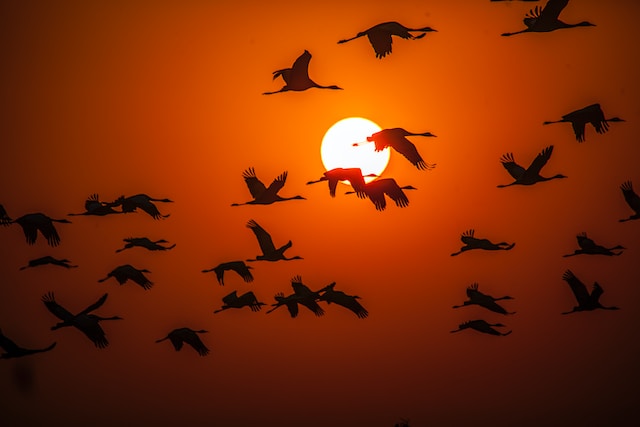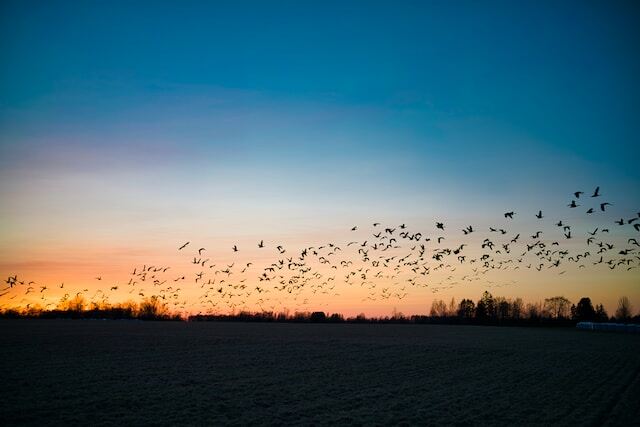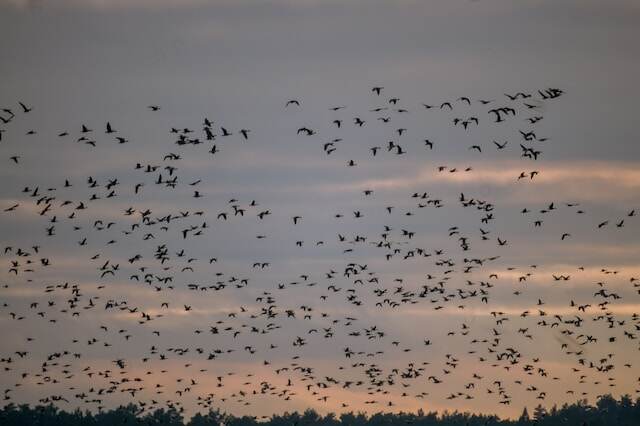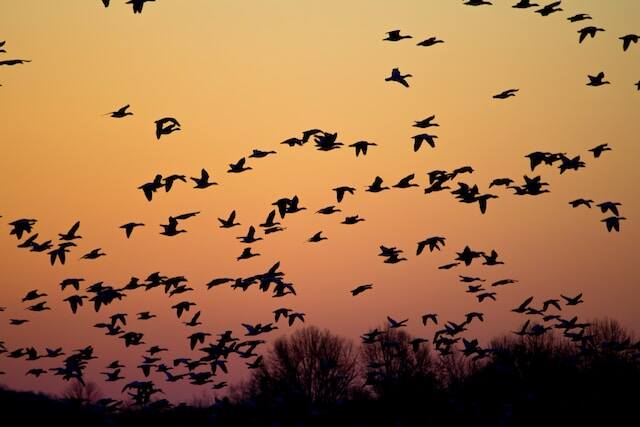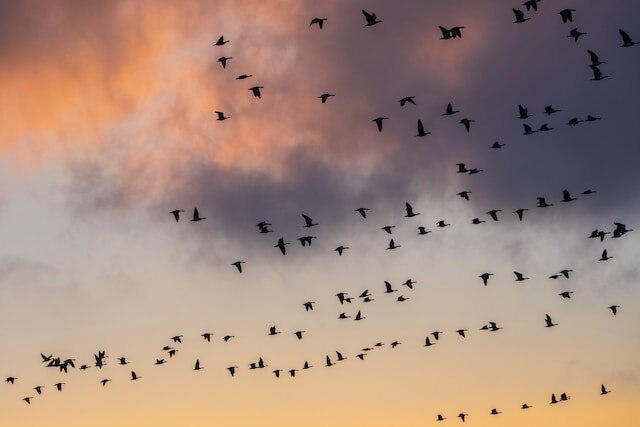Step into the captivating world of nocturnal bird migration, where the night sky becomes a highway for millions of winged travelers. In “Why Do Birds Migrate At Night?” we embark on an illuminating journey to understand the hidden rhythms of nature’s aerial nomads.
Join us as we unveil the extraordinary adaptations and intricate behaviors that propel birds into the darkness, revealing the intricate tapestry of their nighttime journeys across continents and oceans.
Table of Contents
- 1 Definition of Bird Migration
- 2 Importance of Bird Migration
- 3 Explanation of the Topic: Why Do Birds Migrate at Night?
- 4 Theories on Why Birds Migrate at Night
- 5 Physiology and Behavior During Nocturnal Migration
- 6 Technological Advancements in Studying Nocturnal Migration
- 7 Conclusion
- 8 FAQs: Why Do Birds Migrate At Night?
- 8.1 What are the advantages of migrating at night?
- 8.2 How do birds navigate during nighttime migration?
- 8.3 Why do birds avoid daytime migration?
- 8.4 Do all bird species migrate at night?
- 8.5 Are there exceptions to nighttime migration?
- 8.6 Do birds migrate at night throughout the year?
- 8.7 How do birds avoid collisions during nighttime migration?
- 8.8 Do weather conditions affect nighttime migration?
- 8.9 Why do some birds migrate in large flocks at night?
- 8.10 How far can birds migrate during a single night?
- 9 Author
Definition of Bird Migration
Bird migration is defined as the seasonal movement of birds from their breeding grounds to their non-breeding grounds.
This can occur over short or long distances, depending on the species. The majority of migratory birds undertake long-distance migration between continents or hemispheres.
Birds generally follow established routes during migration, known as flyways. These routes are influenced by geography, topography, weather patterns, and other factors such as food availability along the way.
Migratory birds can travel alone or in flocks, ranging from small groups to hundreds of thousands of individuals.
Some species fly continuously without stopping for days or even weeks on end while others make frequent stops along the way to rest and refuel.
Importance of Bird Migration
Bird migration plays an essential role in maintaining biodiversity and ecosystem functioning around the world.
Migratory birds transport seeds and nutrients across vast distances, pollinate plants that are critical for agriculture and maintain food webs by providing a vital source of prey for other animals.
Moreover, migratory birds often serve as indicators of environmental change since their movements are closely tied to seasonal cycles such as climate patterns or land use changes caused by human activities.
Despite their ecological importance, migratory birds face many threats along their journey, including habitat loss, hunting, pollution, and climate change.
Understanding why birds migrate at night can help us develop better conservation strategies to protect them.
Explanation of the Topic: Why Do Birds Migrate at Night?
Birds migrate at night for several reasons. One main reason is that they can avoid predators more efficiently. At night, many predators are less active or can’t see as well, which makes it easier for birds to fly undetected.
Another reason is that nocturnal migration allows birds to use celestial cues such as the stars and moon to navigate.
Since many species of migratory birds are highly adapted to low light environments and have excellent night vision capabilities, it’s easier for them to orient themselves by using these cues rather than during the day.
Migrating at night helps birds conserve energy, since they can fly in cooler temperatures with less turbulence.
This allows them to fly further without expending as much energy as they would during the day, when temperatures are higher and air currents are stronger.
Understanding why birds migrate at night offers important insights into their behavior and physiology.
Through research on this topic, we can develop better conservation strategies that take into account the challenges faced by migratory bird populations around the world.
Theories on Why Birds Migrate at Night
Avoiding Predators: The Predator-Prey Dynamics
Birds, like any other species, are subject to predation. As prey animals, birds have evolved a range of adaptations to avoid and escape from predators.
Migratory birds face several challenges when it comes to avoiding predators during their long-distance travels.
One way in which they have adapted is by migrating at night. By migrating under the cover of darkness, birds can reduce the risk of being spotted by predators from the ground or above.
This is especially important for diurnal migrant species that fly during the day when many predators are active.
Nocturnal migration may also help reduce the risk of encountering daytime avian predators such as raptors.
Examples of Predators
Some of the most common bird predators include raptors (hawks, eagles, etc.), owls, snakes, cats (domestic and wild), and foxes. These predators are known to either ambush or actively hunt their prey.
Advantages of Migrating at Night to Avoid Predators
Migrating at night provides several advantages for avoiding predators:
1) Reduced visibility: During nighttime migrations, birds are less visible due to low light conditions, making it difficult for nocturnal and diurnal predators alike to spot them.
2) Reduced activity of diurnal predators: Many daytime predatory species such as hawks and falcons are inactive during nighttime hours, allowing migrants to pass unnoticed.
3) More cover: Flying under cover of darkness provides extra cover for migrants, who use topography and vegetation as a defense mechanism against aerial attacks.
Birds migrate over incredibly long distances every year in search of better breeding or feeding grounds. Despite traveling thousands of miles across diverse habitats and climates, migratory birds always find their way back home.
How do they do it? The answer lies in their ability to navigate using a variety of cues.
Migratory birds use a range of sensory information to help them navigate. These cues include:
1) Visual cues: Birds use the position of the sun or stars, as well as landmarks such as mountain ranges or coastlines, to orient themselves.
2) Magnetic fields: Many species can detect the earth’s magnetic field and use it for orientation.
3) Celestial cues: The angle of polarized light at dawn and dusk helps birds determine north-south direction.
Migrating at night provides several advantages when it comes to navigation:
1) Clearer views of celestial signals: The absence of sunlight during nighttime migration makes celestial navigational cues easier to detect and follow.
2) Reduced interference from visual cues: During daylight hours, visual cues such as landscape features can interfere with migratory birds’ ability to orient themselves.
3) Less chance for disorientation: Nighttime migration is less likely to be disrupted by disturbance or human influence such as bright lights that could disorientate birds during daylight migration.
Nocturnal migration has allowed bird species to adapt effectively against predators and take advantage of nocturnal navigational clues that benefit optimal navigation during long-distance travels.
Physiology and Behavior During Nocturnal Migration
Birds are remarkably adapted to their nocturnal migration. They have a range of physiological and behavioral adaptations that allow them to fly in the dark without losing their way or becoming disoriented.
Adaptations for Night Flight
Birds have evolved several key adaptations to help them navigate during the night. One of the most important is their visual system, which allows them to see even in very low light conditions.
The eyes of nocturnally migrating birds are especially sensitive to light, allowing them to detect even faint stars and other celestial cues that they use for navigation.
In addition to their eyes, birds also have specialized sensors in their beaks that allow them to detect changes in air pressure and temperature.
These sensors give them information about wind direction and speed, which they use to adjust their flight path as needed.
Birds also have a range of adaptations that allow them to conserve energy during long flights.
For example, many species can reduce their metabolic rate by up to 50% during migration, allowing them to fly further on limited energy reserves.
Eye Structure and Function
The eyes of migratory birds are specialized for low-light conditions. Like many nocturnal animals, they have more rods than cones in their retinas, which gives them better sensitivity in dim light.
In addition, some bird species have extra layers of cells at the back of their retinas that help amplify signals from rods.
This adaptation enhances the sensitivity of these cells even further and allows birds like the Northern Saw-whet Owl (Aegolius acadicus) and Common Poorwill (Phalaenoptilus nuttallii) – both known for night migration – incredible vision under extremely low levels of illumination.
Flight Patterns and Speed
Most migratory birds fly in a distinctive V-formation during the day, but at night they tend to fly in more scattered groups. This is because they rely less on visual cues and more on auditory and olfactory signals for navigation.
During migration, birds also tend to fly at higher altitudes than during the day, possibly to take advantage of prevailing winds or to reduce the risk of collision with other creatures.
Some birds have been found flying at altitudes of up to 9,000 meters (30,000 feet)!
Despite these high altitudes, many migratory birds are capable of sustained flight speeds of more than 60 km/h (37 mph).
Ruby-throated Hummingbirds (Archilochus colubris), for instance – known for their long migrations from North America to Central America – can maintain an average speed of around 48 km/h (30 mph).
Effects on Bird Behavior
Migration has a significant impact on bird behavior, including changes in feeding patterns and social interactions. Many birds spend most of their time during migration focused solely on finding food and rest stops along their route.
When they do stop for food or rest, many species form large flocks that can include hundreds or even thousands of individual birds.
These flocks provide protection from predators and allow individuals to share information about food sources and safe resting locations along the way.
At the same time, nocturnal migration also exposes birds to additional risks. For example, they may be more likely to collide with buildings or other structures that are not visible in low-light conditions.
Overall, these physiological and behavioral adaptations help migratory birds navigate the challenges of nocturnal flight while making their annual journeys across vast distances.
By understanding these adaptations better, we can design conservation measures aimed at protecting them through this difficult part of their lives.
Technological Advancements in Studying Nocturnal Migration
Radar Technology: Flying with the Birds
The use of radar technology in studying bird migration has been a game-changer. Radar systems can detect and track migrating birds, providing valuable information about their patterns and behaviors during flight.
Weather surveillance radar (WSR), originally used to track weather patterns, has been adapted to monitor bird movements.
This technology allows researchers to study large-scale migration patterns, such as the timing and direction of bird movements, while also tracking individual flight speeds.
Radar technology has also made it possible to study nocturnal bird migration at a level of detail previously unimaginable.
By using Doppler radar, researchers can determine the altitude at which birds are flying and how they are interacting with different environmental factors such as wind currents or atmospheric pressure changes.
The use of radar technology in this field has allowed for groundbreaking research on nocturnal migration.
Bird Banding: Following Birds Along Their Journey
Bird banding involves attaching small bands or tags to birds’ legs that allow them to be tracked throughout their migration journey.
This method provides valuable information about bird behavior and ecology, including population size, age distribution, migratory routes, and survival rates.
Bird banding is particularly useful for studying nocturnal bird migration, since it allows researchers to track individual birds’ movements over long distances during both day and night hours.
By analyzing the data collected from banded birds over time, researchers gain insight into how changes in environmental conditions affect migratory behavior.
Bird Call Monitoring: Listening for Clues
Bird call monitoring involves recording sounds made by migrating birds during their journey. By analyzing these recordings, researchers can identify species present in an area over time and learn more about their migratory behaviors.
This method is particularly useful for studying songbirds that migrate at night since they are difficult to observe and track visually.
By analyzing the timing, frequency, and type of calls made by birds during migration, researchers can gain insight into their behavior patterns, as well as their overall health and population size.
The Future of Technological Advancements in Studying Nocturnal Migration
As technology continues to advance, new methods for studying nocturnal bird migration are emerging.
For example, remote sensing techniques such as satellite imagery and acoustic monitoring are being developed to provide even more detailed information about bird behavior during migration.
These advancements in technology have the potential to revolutionize our understanding of nocturnal bird migration.
By gaining a better understanding of these behaviors and patterns, we can develop more effective conservation strategies to protect these important animal populations for generations to come.
Conclusion
Summary of main points
Throughout this article, we have explored the theories and physiology behind why birds migrate at night. It is clear that birds migrate at night to avoid predators and to use navigational cues such as stars and magnetic fields.
Additionally, birds have physical adaptations and changes in behavior during nocturnal migration. Technological advancements in studying bird migration have allowed for more detailed research on this phenomenon.
Importance and relevance to conservation efforts
The study of bird migration is crucial for understanding the ecological systems that maintain balance in our world. Birds play a vital role in pollination, seed dispersal, insect control, and other ecosystem services.
The loss of migratory species can cause a ripple effect throughout ecosystems, impacting both plant and animal populations. Furthermore, understanding the patterns of bird migration can inform conservation efforts.
For example, by tracking migratory routes and important stopover sites, we can protect these areas from human development or other detrimental activities.
Additionally, knowing when and where certain species migrate can help us better understand how climate change may be affecting their populations.
While the reasons behind why birds migrate at night are multifaceted and complex, studying this phenomenon is critical for both scientific understanding and conservation efforts.
By continuing to explore the mysteries of bird migration with innovative technology and rigorous research methods, we can protect these vital species while also learning more about the intricate workings of our natural world.
FAQs: Why Do Birds Migrate At Night?
What are the advantages of migrating at night?
Migrating at night helps birds avoid predators, navigate using celestial cues, take advantage of cooler temperatures, and reduce water loss through evaporation.
Birds use various navigation strategies such as celestial cues (stars, moon), landmarks, Earth’s magnetic field, and their innate sense of direction to navigate during nighttime migration.
Why do birds avoid daytime migration?
Daytime migration exposes birds to predation risks, increases energy expenditure due to heat and wind, and makes navigation challenging without the aid of celestial cues.
Do all bird species migrate at night?
No, not all bird species migrate at night. Some species prefer diurnal migration, especially raptors and waterfowl that rely on thermals and visual cues for navigation.
Are there exceptions to nighttime migration?
Yes, certain factors can influence birds to migrate during the day, such as favorable weather conditions, shorter distances, or when the risk of predation is low.
Do birds migrate at night throughout the year?
No, nighttime migration is primarily observed during the spring and fall seasons when birds travel to breeding and wintering grounds, respectively.
How do birds avoid collisions during nighttime migration?
Birds use vocalizations and specific flight patterns to maintain group cohesion and avoid collisions. They also adjust their altitude based on weather conditions and topography.
Do weather conditions affect nighttime migration?
Yes, weather conditions can influence the timing and intensity of nighttime migration. Favorable winds, clear skies, and suitable temperatures promote higher migration activity.
Why do some birds migrate in large flocks at night?
Birds migrate in flocks for multiple benefits, including reduced predation risk, enhanced navigational abilities, and improved aerodynamic efficiency through drafting.
How far can birds migrate during a single night?
The distance birds can cover during a single night varies by species. Some small songbirds can travel hundreds of miles, while larger birds like shorebirds or waterfowl can cover thousands of miles.


